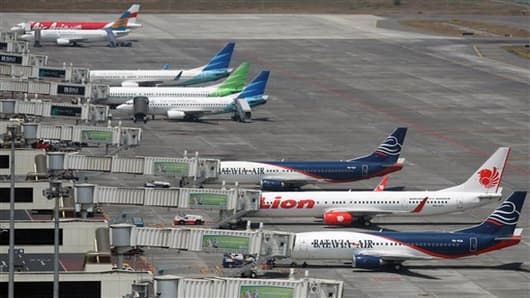Indonesia's economic boom should be a bonanza for airlines clamoring for a slice of the world's fourth-most populous country. But the bankruptcy of its No. 4 airline, Batavia Air, shows how smaller operators are finding it hard to survive.
Batavia became the second budget carrier to run into debt problems in Indonesia in the past two years - a victim of the extremely tight operating margins that exist in what is a crowded market.
And more are likely to go bust.
Transportation ministry data shows there are 22 active local commercial airlines, not including cargo and charter airlines.
In one of the world's fastest growing but most competitive aviation markets, Lion Air, Malaysia's AirAsia, flag carrier PT Garuda Indonesia, and PT Mandala Airlines, part-owned by Tiger Airways, are all expanding capacity.
But smaller operators such as 11-year-old, loss-making Batavia, a nascent international carrier that was declared bankrupt by a court last week after struggling to repay its debts, are feeling the strain.
The low-cost carriers are being forced into selling tickets at a price far below break-even.
"Competition has intensified and the weak will be weeded out," said Shukor Yusof, Singapore-based aviation analyst at Standard & Poor's Capital IQ division. "Smaller players will find it increasingly tough to stay solvent."
Yet, Indonesia presents clear opportunities: by 2030, a further 90 million people will have entered its consumer class, more than any other country except China and India, according to research by consultants McKinsey & Co.
(Read More: Indonesia Defies Weak exports to Post Robust Growth)
Lion Air controls a little less than half of the market, followed by Garuda with about a quarter, Sriwijaya Air with nearly 12 percent and Merpati Nusantara 3 percent.
However, smaller airlines lack the huge cash flow required to sustain loss-making fares, stump up money to acquire coveted landing slots and fund new aircraft.
"The market is very fragmented and highly competitive in Indonesia, so you can also say that if there is one less carrier, that is actually healthy for the industry," said Brendan Sobie, the Singapore-based chief analyst at the Center for Asia Pacific Aviation, an industry consultancy.
"Just because one of the smaller airlines goes bankrupt, it doesn't mean that there's not going to be growth."
Competition Is Just Too Tough
Both Lion Air and AirAsia have placed record plane orders worth billions of dollars with Boeing and Airbus over the last two years.
On the surface, Batavia was full of promise, operating 34 planes in a country with a booming economy and 240 million people spread over 17,000 islands. In July, Southeast Asia's top budget carrier, AirAsia, announced plans to buy Batavia for $80 million.
But by October, AirAsia pulled out, citing risks to the acquisition.
(Read More: Boeing Profit Beats; Sees No 2013 Impact From 787 Grounding)
What Went Wrong?
"The main problem for us is that the competition is too tough," said Sukirno Sukarna, the former commercial director at Batavia. "Our fleets were old, so we can't really sell our tickets at the top-end price limit set by the government while other airlines have newer planes and set the higher prices."
Its books revealed an airline under enormous stress. Although its load factor, the proportion of seats occupied by paying passengers, was between 70 and 80 percent, near the industry average, it was unable to cover costs and sold tickets at prices far below break-even, Sukarna said.
On its busy three-hour route from Jakarta to Ambon in eastern Indonesia, Batavia needed to sell tickets for at least 1.5 million rupiah ($155) each to turn a profit. But facing cut-throat rivals, tickets sold for under 1 million rupiah ($100).
Losses piled up, reaching 310 billion rupiah ($32 million) on revenue of 4.2 trillion rupiah ($434 million) last year, Sukarna added. Total debts swelled to 1.2 trillion rupiah ($124 million), according to a bankruptcy lawyer who handled its assets and declined to be identified by name.
(Read More: Weak Trade, Currency Cool Ardour for Investor Hotspot Indonesia)
"This (Batavia's bankruptcy) indicates how tough the market is now, but the growth is there," Arif Wibowo, chief executive of Garuda's low-cost carrier
Citilink said on the sidelines of an industry event in Singapore. "The growth is always followed by fierce competition."
Batavia, which captured 11 percent of Indonesia's total market in 2011, mainly served local routes with some international destinations including Guangzhou in China and Singapore.
Mandala suspended flights in early 2011 as it struggled with debt. It was taken over by private equity firm Saratoga Capital and Tiger Airways and is flying again.
"This current environment basically allows bigger airlines to get bigger, while smaller airlines will go bust," said Toto Nursatyo, chief commercial officer at Sriwijaya Air. "Those who have bigger capital and bigger market share will thrive while those who just come in and try their luck will struggle."


